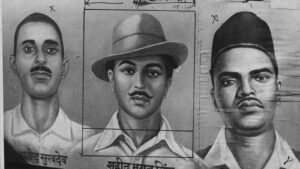Bhagat Singh, a name synonymous with bravery and unwavering commitment to India’s independence, continues to inspire generations. Born on September 28, 1907, in Bange Ki Jatt village, Punjab, Bhagat Singh’s life, though tragically short, was a testament to revolutionary zeal. Growing up amidst the fervor of the Indian independence movement, particularly witnessing the brutal Jallianwala Bagh massacre, Bhagat Singh’s young mind became deeply influenced by the fight against British rule.
Revolution as a Calling: Acts of Defiance
Fueled by a strong sense of nationalism, Bhagat Singh joined the revolutionary organization Hindustan Republican Association (HRA) at a young age. In 1928, enraged by the death of Lala Lajpat Rai, a prominent Indian leader, during a protest against the Simon Commission, Bhagat Singh, along with his comrades, planned to assassinate the British police superintendent responsible. However, in a case of mistaken identity, they shot John Saunders, an assistant superintendent.
This act of defiance, though unintended, propelled Bhagat Singh into the national spotlight. He and his associate Batukeshwar Dutt readily accepted responsibility for the act, using the trial as a platform to condemn British imperialism. Their unapologetic stance and courageous speeches resonated deeply with the Indian public, and Bhagat Singh became a symbol of resistance.
Beyond Violence: The Power of Ideology
While Bhagat Singh’s actions were often portrayed as acts of violence, his core beliefs went beyond mere bloodshed. He envisioned a socialist India free from exploitation. His act of throwing harmless bombs into the Central Legislative Assembly in 1929 was a powerful symbolic protest against British rule. This, along with his hunger strikes to protest the inhuman conditions in prison, further solidified his image as a fearless revolutionary and a champion for social justice.
A Martyr’s Legacy: Inspiring Generations
Bhagat Singh’s execution on March 23, 1931, at the young age of 23, instead of dampening the spirit of revolution, only served to ignite it further. Newspapers across India extensively covered his trial and execution, making him a household name. Bhagat Singh’s defiance in the face of death and his unwavering commitment to his ideals made him a martyr for the Indian independence movement.
Beyond Punjab: A Pan-Indian Icon
Though Bhagat Singh hailed from Punjab, his legacy transcends regional boundaries. He is revered across India as a national hero who epitomized courage, sacrifice, and the unwavering pursuit of freedom. His image adorns countless places, from schools to public spaces, serving as a constant reminder of the fight for independence.
Bhagat Singh’s Legacy: More Than Just a Name
Bhagat Singh’s story is more than just a historical narrative. It serves as a powerful reminder that even young individuals can make a significant impact on the course of history. His unwavering commitment to his ideals and his willingness to fight for a just cause continue to inspire generations to fight for what they believe in, be it social justice, equality, or any other cause they deem important. Bhagat Singh’s legacy is a testament to the enduring power of courage, conviction, and the unwavering pursuit of freedom.
Lahore Conspiracy Case and the Rise of a Hero
In 1928, Singh, along with his friend Shivaram Rajguru, avenged the death of Lala Lajpat Rai, a prominent Indian leader, by fatally shooting British police officer John Saunders. Though they intended to target the official responsible for Lalaji’s demise, it was a case of mistaken identity. This act of defiance, known as the Lahore Conspiracy Case, catapulted Singh into the national spotlight.
During his trial, Singh and his comrades used the courtroom as a platform to propagate their revolutionary ideas. They refused to defend themselves, owning their actions and highlighting the oppressive nature of British rule. This act of defiance further cemented Singh’s image as a fearless revolutionary.
The Assembly Bombing and the Embrace of Martyrdom
In 1929, Singh, along with Batukeshwar Dutt, strategically bombed the Central Legislative Assembly in Delhi. They did not intend to cause casualties. Their purpose was to create a dramatic spectacle, to draw attention to the ongoing struggle for India’s independence. They courted arrest, further igniting public discourse on the legitimacy of India’s fight.
Despite immense public pressure for clemency, Singh was sentenced to death for the Lahore Conspiracy Case. He faced the gallows with unwavering resolve, becoming a martyr for India’s freedom cause on March 23, 1931, at the young age of 23.





